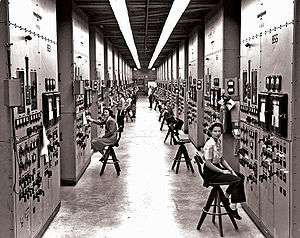Calutron Girls

The Calutron Girls were a group of young women, mostly high school graduates who joined the World War II efforts in Oak Ridge, Tennessee in 1945.[2]
Although they were not allowed to know at the time, they were monitoring dials and watching meters for a calutron, a mass spectrometer that separates uranium isotopes.[3] The enriched uranium was used to make the first atomic bomb.
Calutron Girls were trained and employed at the Y-12 National Security Complex.[4] Wartime labor shortages forced the Tennessee Eastman Corporation to hire women to work at the Y-12 plant.
According to Gladys Owens, one of the few Calutron Girls, a manager at the facility once told them: "We can train you how to do what is needed, but cannot tell you what you are doing. I can only tell you that if our enemies beat us to it, God have mercy on us!"
References
- ↑ Yifat Gutman; Adam Brown; Amy Sodaro (6 October 2010). Memory and the Future: Transnational Politics, Ethics and Society. Palgrave Macmillan UK. pp. 168–. ISBN 978-0-230-29233-8.
The image of the Calutron Girls and the rest of the collected photographs offer a very idealized version of the work that was done at the atomic factories, even the ... Ed Westcott, Courtesy of National Archives and Records Administration.
- ↑ Lindsey A. Freeman (13 April 2015). Longing for the Bomb: Oak Ridge and Atomic Nostalgia. University of North Carolina Press. pp. 73–. ISBN 978-1-4696-2238-5.
- ↑ Diane Fanning (1 November 2014). Scandal in the Secret City: A World War Two mystery set in Tennessee. Severn House Publishers. pp. 8–. ISBN 978-1-78010-568-0.
- ↑ Duane S. Nickell (2010). Guidebook for the Scientific Traveler: Visiting Physics and Chemistry Sites Across America. Rutgers University Press. pp. 142–. ISBN 978-0-8135-4730-5.
These “calutron girls” were trained to sit and watch meters on the control panels and make adjustments if the needles moved too far in one direction or the other. ... At Oak Ridge, the diffusion process was housed in the titanic K-25 building.
Further reading
- Denise Kiernan (11 March 2014). The Girls of Atomic City: The Untold Story of the Women Who Helped Win World War II. Simon and Schuster. ISBN 978-1-4516-1753-5.
- Ray Smith (9 February 2013). 2006 Historically Speaking : As published in the Oak Ridger Newspaper. pp. 133–. ISBN 978-1-257-23331-1.